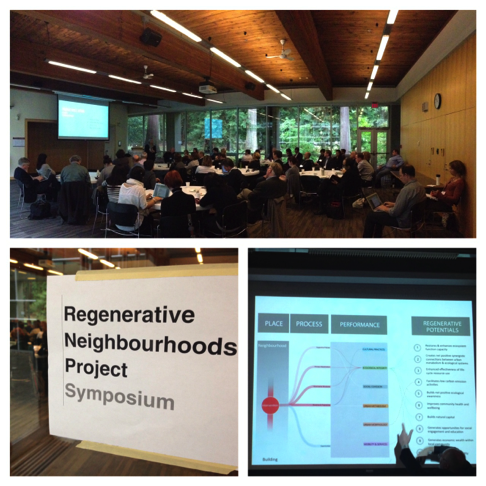Less harm, more good. Sounds like a no-brainer. Who would argue with that idea? Don’t just build a green building – build one in a way that, when placed in a neighborhood, it reduces the overall carbon liability of that community, or more. How about water, health, knowledge, food, identity and mobility?
I recently participated in a regenerative neighborhoods symposium at the University of British Columbia (UBC), in Vancouver – a geek-fest on all things regenerative design, but with a focus at the neighborhood scale. The symposium is part of the Regenerative Neighborhood Project, an important piece of research being undertaken by UBC’s School of Architecture and Landscape Architecture.
UBC has been a research leader in sustainability for some time, using its own campus as a living laboratory as it builds high performing buildings across the numerous neighborhoods on campus. It’s a city in its own right, really. And what better setting to explore and practice regenerative design at a building and neighborhood level? The campus is now home to, from my assessment, the only dedicated regenerative neighborhood initiative globally.
 So what’s next for the Regenerative Neighborhood Project? Well, the aspiration is a Regenerative Neighborhoods Framework. The symposium last week was the last in a series dedicated to helping shape the research output and create the framework. EcoDistricts’ involvement provided an example of a framework, the EcoDistricts Protocol that is seeking to progress a new process, a new way of approaching development.
So what’s next for the Regenerative Neighborhood Project? Well, the aspiration is a Regenerative Neighborhoods Framework. The symposium last week was the last in a series dedicated to helping shape the research output and create the framework. EcoDistricts’ involvement provided an example of a framework, the EcoDistricts Protocol that is seeking to progress a new process, a new way of approaching development.
Moving from our very mechanistic view of sustainability (that has us embedded in rating tools) to a more ecological view is at the core of the project. Neighborhoods that create positive feedback loops, giving more than they take, is just one important characteristic of a regenerative neighborhood. In order to achieve this goal, we need a new framework of thinking, and doing. And this is well on its way, with the UBC 20 year Sustainability Strategy itself embedding the concept of regenerative neighborhood design. The flow through of this design approach into UBC’s capital projects is now happening. One example is the Orchard Commons, a mixed-use multiple building housing hub on campus that includes retail, day care facilities and end of trip infrastructure. Through a new design briefing process, regenerative neighborhood principles and indicators are embedded to ensure consultants and contractors are accountable to the standards set.
But despite UBC’s step-by-step regenerative neighborhoods success stories on its own campus, there is a clear need for more implementation by developers and municipal governments in their redevelopment projects. And at last week’s symposium, it was acknowledged that there continues to be an underrepresentation from the private sector development community.
How do we engage these critical but overall absent stakeholders? Maybe it’s the messaging we often set around this regenerative concept. As developers are trying to do less bad, regeneration is asking for more good. I have seen my fair share of powerpoint presentations at conferences with renderings splashed across the slides by architects ‘loading up’ buildings with vegetation – building designs purporting to give more than they take. And we are yet to see these convert to reality. So, in scaling up to a neighborhood level, we not only have the challenge of greater complexity and challenge, but also of our communication and messaging on the subject.
This is why we need to produce a set of regenerative neighborhood prototypes, some typical and preliminary models that allow us to greater articulate the end state, and what it means for key stakeholders like the development industry to invest in these projects. As I now pack my bags and head to Greenbuild to rub shoulders with the worlds green building elite, there may just be some hope in attracting the interest of a willing coalition of leaders to help prototype what the regenerative neighborhood of the future just might look like. Stay tuned!
